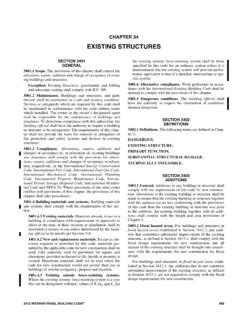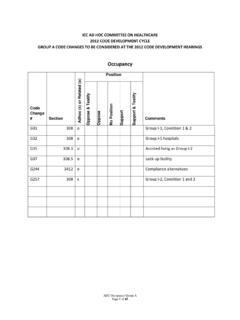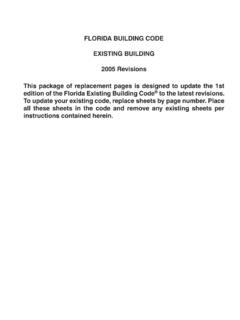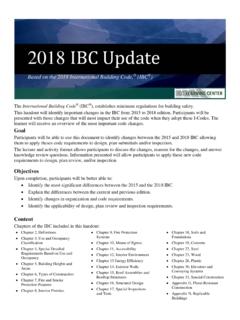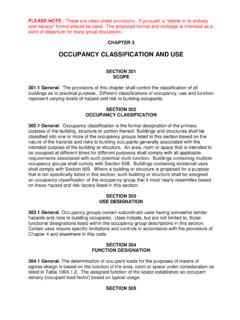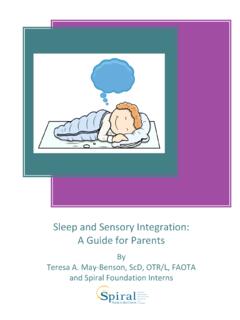Transcription of Session: 2018 IRC Essentials - Design Criteria ...
1 Session: 2018 IRC Essentials - Design Criteria , foundations , Framing and Finishes 2018 IRC Essentials Based on the 2018 International Residential Code (IRC ). Apply the critical concepts provisions of the 2018 International Residential Code . 2018 IRC Essentials Explain the fundamental provisions Nick Youngson - link to - of the 2018 IRC. Locate general topics and applicable tables in the 2018 IRC. Define terms essential for correct code interpretation. Identify the code that relates to the Design , construction or inspection of residential building. 2018 IRC Essentials Tips guide to a successful class: Slides contain some text and iconic images to help you learn. Text and commentary is in the handout. Follow along in the course handout. Ask Questions, ask questions, ASK QUESTIONS!!!! 2018 IRC Essentials Outline Overview Part V: Health and Part I: Code Safety Administration and Part VI: Building Enforcement Utilities Part II: Site Part VII: Energy Development Conservation Part III: Structural Part VIII: Protection Part IV: Finishes and from Other Hazards Weather Protection Summary, Q and A and Debrief 2018 IRC Essentials Site Preparation Location on Property Measured perpendicular to the exterior wall Measured between the building and: Lot lines Centerline of a street or alley 2018 IRC Essentials Workbook Page 29-30.
2 Site Preparation Two basic provisions: Soil characteristics as they relate to the support and stability of foundations Grading to provide surface drainage away from foundations 2018 IRC Essentials Workbook Page 31. General Requirements Exterior footings Minimum of 12 below the undisturbed ground level Protected against frost All footings must bear on: Natural soil; or Compacted engineered fill 2018 IRC Essentials Workbook Page 31. Presumptive Load-bearing Values & Properties of Soils Unified Soil Load Volume Classification Bearing Drainage Frost Heave Change Soil Description System Pressure Characteristics Potential Potential Symbol (psf) Expansion Well-graded gravels, gravel sand mixtures, little or no GW 3000 Good Low Low fines Poorly graded gravels or gravel sand mixtures, little or GP 3000 Good Low Low no fines SW Well-graded sands, gravelly sands, little or no fines 2000 Good Low Low SP Poorly graded sands or gravelly sands, little or no fines 2000 Good Low Low GM Silty gravels, gravel-sand-silt mixtures 2000 Good Medium Low SM Silty sand, sand-silt mixtures 2000 Good Medium Low GC Clayey gravels, gravel-sand-clay mixtures 2000 Medium Medium Low SC Clayey sands, sand-clay mixture 2000 Medium Medium Low Inorganic silts and very fine sands, rock flour, silty or ML 1500 Medium High Low clayey fine sands or clayey silts with slight plasticity Inorganic clays of low to medium plasticity, gravelly Medium CL clays, sandy clays, silty clays, lean clays 1500 Medium Medium to Low CH Inorganic clays of high plasticity, fat clays 1500 Poor Medium High Inorganic silts.
3 Micaceous or diatomaceous fine sandy MH 1500 Poor High High or silty soils, elastic silts Workbook Page 32. Fill Engineered fill is required for: Over-excavation to remove unsuitable soils Additional material to raise the elevation of the footings above the existing undisturbed soil Engineered fill must be: Designed by a registered Design professional Installed as specified in Design requirements Tested as specified in Design requirements 2018 IRC Essentials Workbook Page 33. Storm Drainage Final grade Minimum fall 6 within 10' of foundation Exception for local site conditions Water can be directed to swales or drains Concrete surfaces within 10' of the foundation need 2%. slope 2018 IRC Essentials Workbook Page 34. Storm Drainage 2018 IRC Essentials Workbook Page 35. Structural Table (1). Climatic and Geographic Design Criteria IRC adoption: jurisdiction completes table with data applicable to the jurisdiction for example: Wind Design Seismic Ground Speed Topographic Special Wind Wind-borne Design Snow Load (mph).
4 Effects Region Debris Zone Category Vult Yes Yes Identify or or or 30 psf 115 mph B. No No No 2018 IRC Essentials Workbook Page 39. Table (1) (Continued). Climatic and Geographic Design Criteria IRC adoption: jurisdiction completes table with data applicable to the jurisdiction for example: Subject to Damage from Ice Barrier Underlayment Weathering Frost Line Depth Termite Required Negligible Yes Yes or or or Moderate 42 in. No No or Severe 2018 IRC Essentials Workbook Page 39. Table (1) (Continued). Climatic and Geographic Design Criteria Winter Air Mean Flood Design Freezing Annual Hazards Temp Index Temp Date NFIP, 2 F 1197 51 F. Etc. 2018 IRC Essentials Workbook Page 39. Table (1) (Continued). Climatic and Geographic Design Criteria Manual J Design Criteria Elevation Latitude Winter Summer Altitude Indoor Design Heating Cooling Correction Design Temp. Factor Temp. Cooling Heating Cooling Wind Wind Coincident Daily Winter Summer Temp. Temp. Velocity Velocity Wet Bulb Range Humidity humidity Differ.
5 Differ. Heating Cooling 2018 IRC Essentials Prescriptive and Performance Prescriptive requirements A specific set of rules to follow Performance requirements Expectation that the system will function in a certain way For structural requirements, performance is achieved through engineering 2018 IRC Essentials Workbook Page 39. Prescriptive and Performance Conventional construction Engineered Design can be used for structural elements that: Exceed the limits in the code; or Are not included in the code Alternative to wood framing For example, the sizing of provisions wide flange steel beams Wood Frame Construction Manual published by the American Wood Council WFCM addresses wind speeds up to 150 mph IRC wind speeds are less than 110 mph 2018 IRC Essentials Workbook Page 39. Live Loads IRC Table Minimum Uniformly Distributed Live Loads LIVE LOAD. USE. (psf). Uninhabitable attics without storage 10. Uninhabitable attics with limited storage 20. Habitable attics and attics served with 30.
6 Fixed stairs Balconies (exterior) and decks 40. Fire escapes 40. Rooms other than sleeping rooms 40. Sleeping rooms 30. 2018 IRC Essentials Workbook Page 40-42. Live Loads (Continued). IRC Table Minimum Uniformly Distributed Live Loads LIVE LOAD. USE. (psf). Guardrails and Single concentrated load applied in 200. handrails any direction along the top. Guardrail in-fill Horizontally applied normal load of 50. components 50 lb. on area of 1 sq. ft. Passenger 2,000-lb concentrated load / 20-sq. 50. vehicle garages in. area. 300-lb concentrated load / 4 sq. in. Stairs 40. of tread 2018 IRC Essentials Workbook Page 40-42. Dead Loads Average dead loads are included in the prescriptive tables for: Footings Floors Walls Roofs For example, spread footing sizes for conventional frame construction assume average weights for the construction materials being supported 2018 IRC Essentials Workbook Page 42. Deflection Allowable deflection in structural framing members: Allowable Structural Member Studs Deflection Joists Rafters having slopes greater than 3:12 with L/180.
7 No finished ceiling attached to rafters Beams Interior walls and partitions H/180. Rafters Floors/ceilings with plaster or stucco finish L/360. Table All other structural members L/240. L = span length Exterior walls wind loads with plaster or H/360. stucco finish H = span height Exterior walls with other brittle finishes H/240. Exterior walls with flexible finishes H/120. Lintels supporting masonry veneer walls L/600. 2018 IRC Essentials Workbook Page 42-43. Example 4-1 floor Joist Deflection floor joist span is 14'. Allowable deflection from Table is L/360. L = 14' x 12 = 168 . 168 360 = Allowable deflection is . Note: a 14' span rafter with 4:12 slope and no ceiling attached has an allowable deflection of L/180, which is twice the deflection allowed for floor joists 2018 IRC Essentials Workbook Page 43. Wind Loads Wind forces acting on buildings IRC conventional framing limits wind speed to 140 mph Vult (130. in hurricane prone areas). AWC Wood Framing Construction Manual (WFCM).
8 ICC 600 Standard for Residential Construction in High-Wind Regions ICC International Building Code ASCE 7 Minimum Design Loads for Buildings and Other Structures 2018 IRC Essentials Workbook Page 44. Wind Exposure Category Exposure B. Some wind protection with trees and buildings Default Exposure C. Wind exposure B. Open terrain with scattered obstructions Exposure D. Flat, unobstructed areas exposed to open water, smooth mud flats, salt flats and unbroken ice for 5,000 ft Wind exposure C. 2018 IRC Essentials Workbook Page 45. Hurricane-prone regions Hurricane-prone regions. Areas vulnerable to hurricanes, defined as the Atlantic Ocean and Gulf of Mexico coasts where the ultimate Design wind speed, Vult, is greater than 115 miles per hour , and Hawaii, Puerto Rico, Guam, Virgin Islands and America Samoa. Windborne debris region. Areas within hurricane-prone regions located in accordance with one of the following: 1 mile of the coastal mean high water line where the ultimate Design wind speed, Vult, is 130 mph or greater.
9 2. In areas where the ultimate Design wind speed, Vult, is 140 mph or greater; or Hawaii. 2018 IRC Essentials Workbook Page 46. Snow Loads Snow loads must be considered where applicable IRC and WFCM conventional framing tables are limited to snow load <70 psf 2018 IRC Essentials Workbook Page 47. Earthquakes Seismic Design 1- and 2-Family Townhouses Category Dwellings A&B No seismic requirements No seismic requirements Seismic Requirements C No seismic requirements Apply D0, D1, D2 Seismic Requirements Apply E Engineered Design Required The IRC assigns a Seismic Design Category to building sites relative to the anticipated intensity and frequency of earthquakes Prescriptive provisions of the IRC are adequate for SDC A and B. 2018 IRC Essentials Workbook Page 48-50. Earthquakes Regularly shaped buildings Uniform distribution of forces More predictable response characteristics Irregularly shaped buildings Force concentrations Generally less effective in resisting earthquake load effects 2018 IRC Essentials Workbook Page 49.
10 Foundation Materials Concrete Removable forms Stay-in-place insulating concrete forms (ICF). Precast concrete Masonry Wood Engineered or alternative designs 2018 IRC Essentials Workbook Page 53. Footings Footings must bear on undisturbed ground Footings must extend below the frost depth Exterior footings 12 below undisturbed ground level Detrimental materials removed prior to placing concrete 2018 IRC Essentials Workbook Page 54. Size of Concrete Footings Conventional Light-Frame Construction Snow load Load bearing value of soil Type of foundation 30 psf 1,500 2,000 2,500. Slab-on-grade 12 x 6 12 x 6 12 x 6. 1-story With crawl space 13 x 6 12 x 6 12 x 6. Plus basement 19 x 6 14 x 6 12 x 6. Slab-on-grade 12 x 6 12 x 6 12 x 6. 2-story With crawl space 17 x 6 13 x 6 12 x 6. Plus basement 23 x 6 17 x 6 14 x 6. Projection P 2 in. and T. Thickness T 6 in. Width W per table 2018 IRC Essentials Workbook Page 56. Example 5-1. Footing Size Determine minimum width (W), projection (P) and thickness (T) of a continuous spread footing Given: 2-story dwelling with basement 1500 psf assumed soil bearing capacity 30 psf snow load Conventional construction: a) Light-frame construction with siding b) Light-frame construction with brick veneer 2018 IRC Essentials Workbook Page 57.

